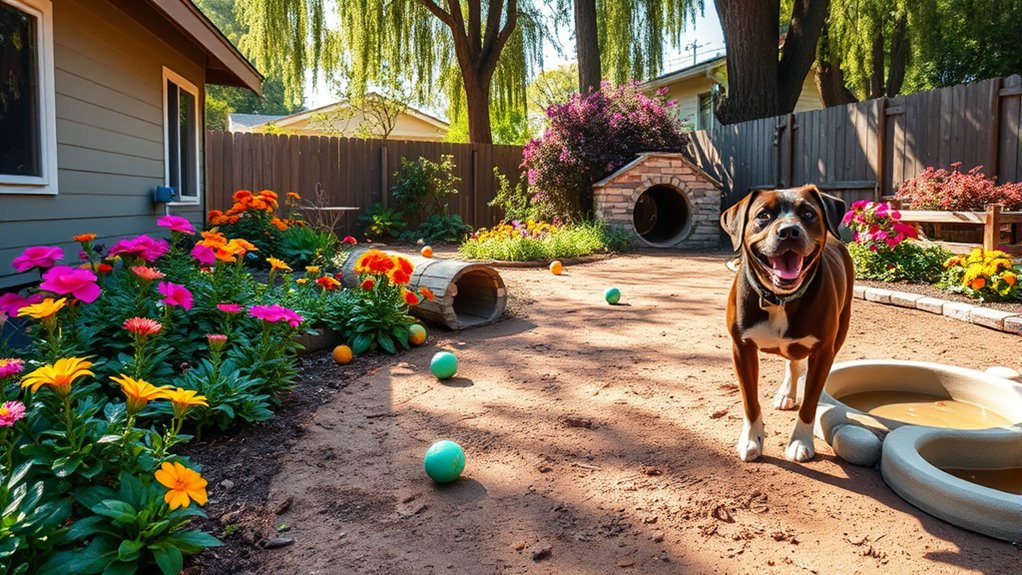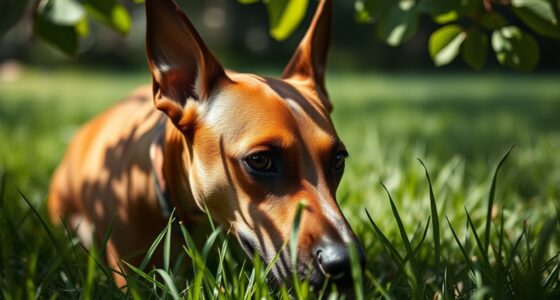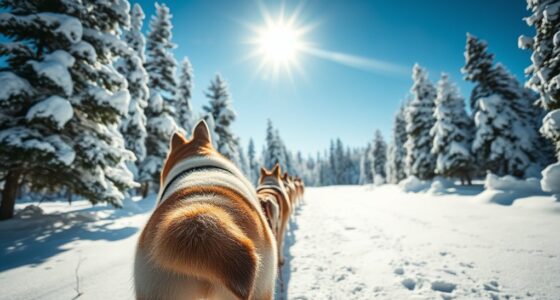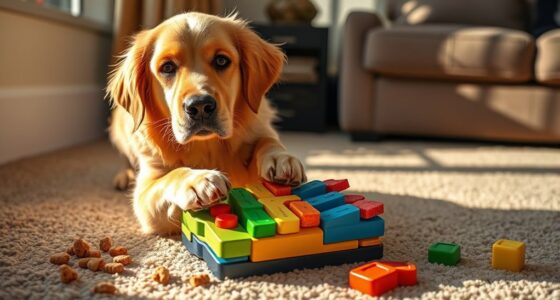To create an enrichment garden for your dog, choose non-toxic, sensory-rich plants like mint, rosemary, and marigolds, and avoid toxic ones. Design spaces for exploration, sniffing, and digging, using pathways or raised beds to keep plants safe. Add water features, hidden toys, and shaded areas to promote activity and comfort. Regular care keeps the environment healthy and stimulating. Keep exploring options to develop a vibrant, safe outdoor haven that your dog will love.
Key Takeaways
- Select non-toxic, sensory-rich plants like mint, marigolds, and rosemary to stimulate your dog’s senses safely.
- Design dedicated zones for sniffing, digging, resting, and water play to encourage natural behaviors.
- Incorporate puzzle feeders and hidden toys among plants for mental stimulation and enrichment.
- Use pathways, raised beds, and barriers to organize the space and protect both plants and your dog.
- Maintain the garden regularly by trimming, cleaning, and monitoring for safety to ensure a healthy, engaging environment.

Creating an enrichment garden at home offers a rewarding way to connect with nature and boost your well-being. When designing this space for your dog, you want it to be both stimulating and safe. The first step involves careful plant selection. Choose plants that are non-toxic and safe for dogs, such as herbs like basil, mint, and rosemary, or colorful flowers like marigolds and pansies. Avoid plants known to be toxic, like azaleas, lilies, and certain bulbs. Incorporating a variety of textures and smells will provide sensory enrichment for your dog, encouraging exploration and mental engagement. Selecting plants that are resilient and easy to maintain helps guarantee your garden remains inviting and safe over time.
Creating a safe, stimulating dog-friendly garden with non-toxic plants and sensory-rich varieties enhances your pet’s well-being.
Next, focus on the garden layout. Plan your space with your dog’s activity levels and natural behaviors in mind. Create distinct zones within the garden—an area for sniffing and exploring, a section with soft grass or turf for resting, and perhaps a spot for digging, if your dog enjoys that activity. Incorporate pathways or stepping stones to guide your dog through different parts of the garden, preventing them from trampling sensitive plants. You might also add raised beds or containers, making it easier to control plant placement and keep potentially harmful plants out of reach. Use fencing or natural barriers to define boundaries and keep your dog safe from wandering off or getting into unsafe areas.
Consider incorporating features that enhance the garden’s functionality. Add a water feature or a shallow pond if your dog enjoys water play, making sure it’s secure and clean. Install outdoor toys or puzzle feeders hidden among the plants to stimulate your dog’s mind. Be mindful of the placement of these items, avoiding clutter that could cause injury or make the space feel chaotic. Shade is essential, so position some plants or structures that provide shelter from the sun, keeping the area comfortable during hot days. Additionally, incorporating elements like natural materials can help create a more authentic and inviting environment.
Finally, maintain your garden regularly to keep it safe and inviting. Trim plants that grow too quickly, remove any fallen leaves or debris, and check for any signs of pests or plant disease. This ongoing care ensures that your garden remains a healthy environment for your dog to explore and enjoy. By thoughtfully selecting plants and designing a well-planned garden layout, you’ll create a vibrant, engaging outdoor space that nurtures your dog’s physical and mental health while allowing you to enjoy the beauty of nature right at home.
Frequently Asked Questions
What Are the Best Plants to Include in a Dog-Friendly Garden?
You should include dog-friendly plant varieties like lavender, rosemary, and marigolds, which are non-toxic garden plants safe for your dog. These plants not only add beauty to your garden but also provide sensory stimulation and a safe environment for your pet to explore. Avoid plants like azaleas or lilies, which are toxic. Keep your garden safe by choosing non toxic garden plants and dog-friendly plant varieties that encourage healthy outdoor play.
How Can I Ensure My Dog’s Safety in the Garden?
To keep your dog safe in the garden, start with fencing considerations—ensure it’s secure, tall enough, and free of gaps. Regularly check for potential hazards like sharp objects or toxic plants. Use pest control methods that are pet-safe, such as natural repellents or manual removal. Keep an eye on your dog when outside, and train them to stay within designated safe areas. This way, your garden remains a fun, secure space for your furry friend.
What Tools Are Essential for Building an Outdoor Dog Enrichment Space?
Think of building your dog’s paradise as planting a seed for joy. You’ll need basic garden design tools like shovels, rakes, and gloves to shape the space. Outdoor furniture, such as sturdy benches or a small table, provides resting spots. A secure fence and digging barriers are essential for safety. Don’t forget a water source for hydration and some durable toys to keep your pup entertained.
How Often Should I Update or Change Garden Activities for My Dog?
You should update or change garden activities for your dog seasonally, about every 2-3 months, to keep things fresh and engaging. Incorporate seasonal activity changes like new scents, toys, or obstacle setups that match the weather and your dog’s interests. Regularly assess your dog’s enthusiasm and adapt the garden to prevent boredom, ensuring they stay stimulated and happy. Frequent updates help maintain their curiosity and physical activity levels.
Are There Any Plants That Are Toxic to Dogs I Should Avoid?
Your garden can be a paradise or a danger zone for your dog! Avoid poison flowering plants like azaleas, lilies, and daffodils, which are highly toxic. Stick with dog-safe herbs like basil, rosemary, and parsley to keep your pup healthy and happy. Always double-check plants before planting and keep poisonous plants out of reach. Your dog’s safety depends on your plant choices—make your garden a safe haven!
Conclusion
By creating an enrichment garden, you’re giving your dog a space to explore, play, and relax. This effort not only keeps them happy and healthy but also strengthens your bond. Remember, a well-tended garden is like a well-tended friendship—both flourish with care and attention. So, start planting today, and watch your furry friend thrive in their new outdoor haven. After all, a little effort today yields a lifetime of joy tomorrow.










